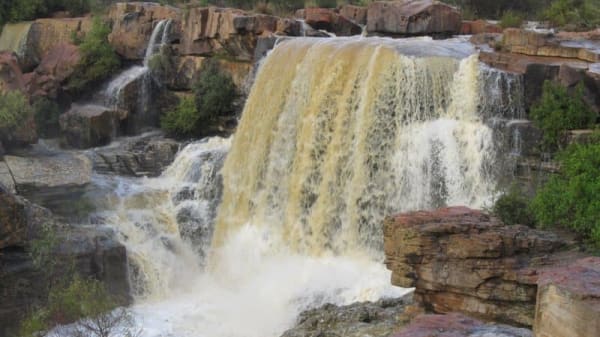The village of Nieuwoudtville lies on the Bokkeveld Plateau, where the Cape Fynbos meets the Hantam Karoo, Boesmanland and the Knersvlakte. It is a place where the experience of silence, space and stars contribute to a tranquil way of life.
Visit the Neo-Gothic Sandstone Church (National Monument), local Historical Sandstone Ruins, Quiver Tree Forest (Aloe Dichotoma); Glacial Pavement; abundant Rock Art; the local Bulb Nursery; Nieuwoudtville Wild Flower Reserve; Hantam National Botanical Garden; Oorlogskloof Nature Reserve and the Nieuwoudtville Waterfall Reserve.
Outdoor activities can be enjoyed – including: caravanning; bird watching; hiking; cycling; 4 x 4 routes and stargazing.
Environment
The great diversity of flowers, and particularly geophytes, that occur on the Bokkeveld is what makes Nieuwoudtville both special and different from the rest of Namaqualand.The diversity of geophytes is particularly astounding. The area around Nieuwoudtville has 309 species of geophyte. To put this in perspective, there are about 1551 geophytes in the entire Cape flora and this is 4-5 times richer than other Mediterranean regions such as California, Western Australia, and the Mediterranean basin. In good rainfall years the display of spring annuals around Nieuwoudtville transforms the landscape into a picture of colour, and when these have set seed there are still many interesting flowers to be found long after the first flush of spring.
Nieuwoudtville is renowned for its high number of bulbous plants. The variety of flowers is immediately obvious, but there is an equally amazing diversity of below ground structures. Plants that can store reserves underground, where they won’t dry out, and that have a dormant period during the hottest months when they don’t have leaves or stems above ground, are well suited to survive the summer droughts that occur in Nieuwoudtville.
Botanists refer to these plants as geophytes and the below ground structures may be classified as bulbs, corms, rhizomes, or tubers.In some areas around Nieuwoudtville there may be as many as 25 000 geophytes per square metre, but it is more usual to find a few hundred plants. At this density, a spadefull of soil will contain more than 100 bulbs and corms.
Part of the reason for this abundance seems to be the different ways in which these plants survive the combined effects of drying out and being eaten. An underground bulb or corm may escape the hot sun but it also provides a potential meal for porcupines and mole rats. A single porcupine could eat several hundred bulbs a night so surviving being eaten can be as important as escaping desiccation.
Some geophytes have shallow bulbs with low nutritional value and a high water content.
Some of these bulbs may reach the size of a football (e.g. Boophone). Others have small corms or bulbs that are buried deep in the soil (e.g. Wurmbea), reaching into the rocky layer where they are well protected. Still others are designed to break up when they are disturbed, so the primary bulb or corm is surrounded by numerous bulbils or cormlets.
There are also some species that occur only among rocks where they are less likely to be uprooted by porcupines (e.g. Babiana framesii in the dolerite koppies). High densities of geophytes are found where the different types occur together or where porcupines constantly dig over the soil resulting in high numbers of those species with bulbils and cormlets.
Dolerite Koppies
The north-south row of dolerite koppies to the east of Nieuwoudtville are the remains of a dolerite sill. Dolerite sills and dykes are intrusions of igneous rock formed by molten magma from the Earth’s mantle that forced its way to the surface through cracks in the rock layers.
Nieuwoudtville Falls
The Nieuwoudtville Waterfall is found north of the lovely little town of Nieuwoudtville in the Northern Cape’s Great Karoo. Spectacular after good summer rains, they are formed where the Doring River drops 100m down to a rock pool.
- Visit the spectacular Nieuwoudtville Falls
- Dolerite Koppies
- Enjoy bird-watching, hiking, cycling, 4x4 trails and stargazing
- There are a variety of lovely restaurants in the area including Die Nedersetting restaurant and Die Waenhuis
- Ruins at die Ou Plaas
- Hantam National Botanical Gardens
The Khoi San inhabited this area for many centuries before the first settlers arrived in about 1730, and local rock art in Oorlogskloof Nature Reserve and on farms around Nieuwoudtville bears witness to an ancient culture that flourished here. During this period vast herds of game periodically roamed the plains of the Bokkeveld Plateau (Antelope Plateau), after which it derived its name.
In the late 1700s wild herds had been replaced by large herdsof sheep and cattle belonging to the settlers. The early settlers established themselvesclose to the present town of Nieuwoudtville at Groenrivier and Willemsrivier, where the first formal church building still stands.


